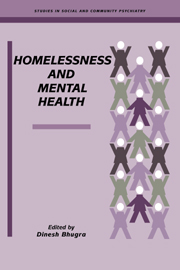Book contents
- Frontmatter
- Contents
- List of contributors
- Preface
- Part I INTRODCTION AND SPECIAL GROUPS
- Part II SERVICES
- 7 Services for the mentally ill homeless
- 8 Clinical work with homeless people in the USA
- 9 The severely mentally ill in hostels for the homeless
- 10 Old and homeless in London and New York City: a cross-national comparison
- 11 Primary health care of the single homeless
- Part III INTERNATIONAL PERSPECTIVE
- Part IV POLICY AND EVALUATION
- Index
8 - Clinical work with homeless people in the USA
from Part II - SERVICES
Published online by Cambridge University Press: 15 October 2009
- Frontmatter
- Contents
- List of contributors
- Preface
- Part I INTRODCTION AND SPECIAL GROUPS
- Part II SERVICES
- 7 Services for the mentally ill homeless
- 8 Clinical work with homeless people in the USA
- 9 The severely mentally ill in hostels for the homeless
- 10 Old and homeless in London and New York City: a cross-national comparison
- 11 Primary health care of the single homeless
- Part III INTERNATIONAL PERSPECTIVE
- Part IV POLICY AND EVALUATION
- Index
Summary
Although psychiatric epidemiologists had demonstrated as early as the 1960s that the prevalence of psychiatric disorders was high among American homeless people, such as those who frequented the Bowery in New York (Spitzer et al, 1969), it was not until the late 1970s that the issue was compellingly brought to the attention of American psychiatry (Reich & Siegel, 1978) and not until the 1980s that, stimulated by the National Institute of Mental Health, significant programmes of research and service development got under way (Tessler & Dennis, 1989).
In the past decade the problem of homelessness in the USA has, if anything, become more severe and there has been little improvement, overall, in the plight of the homeless mentally ill. After 10 years of research and programme development, however, the nature and extent of the problems are better documented and there has been progress in developing treatment, rehabilitation and resettlement approaches (Institute of Medicine, 1988; Burt & Cohen, 1989; Brickner et al, 1990; Jahiel, 1992; Lamb et al, 1992a; Robertson & Greenblatt, 1992).
Nevertheless, homelessness continues to be surrounded by debate and controversy, even as data on the problem accrue and the general public becomes increasingly resigned to the sight of homeless people in the streets and public places. The public perception continues to be that the homeless constitute a distinct class of individuals, alienated from the mainstream of society, often threatening to, or challenging, the general population of domiciled people. Among those who work with the homeless, however, the notion of an underclass has given way to a view of homelessness as a state into which people arrive for a wide variety of reasons.
- Type
- Chapter
- Information
- Homelessness and Mental Health , pp. 110 - 132Publisher: Cambridge University PressPrint publication year: 1996



